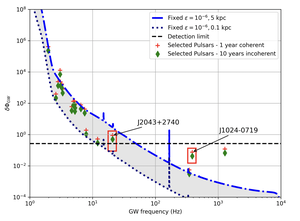Pulsars are rapidly rotating neutron stars, whose rotation rate can be accurately tracked with the aid of radio telescopes and other electromagnetic observatories. While pulsars are generally very stable `clocks’, rivaling atomic clocks in precision, their rotation rate is known to wander of long timescales, leading to what is known as `timing noise’. The origin of this noise is not entirely known. The leading hypothesis are that it may be due either to fluctuations in the magnetosphere or in the coupling between the normal matter of the star and interior superfluid components.
Intriguingly, these internal components may be linked to gravitational wave emission, so that observations of the continuous gravitational signal from these stars could allow us to track the motion of the interior. While these kinds of signals from gravitational wave pulsar have not yet been discovered, the sensitivity of current detectors is getting to the point where it is important to study them in detail.
In recent work, Gravitational pulsars: correlations between the electromagnetic and the continuous gravitational wave signal, the authors Marco Antonelli, Avishek Basu and Brynmor Haskell (from the Copernicus Astronomical Center in Warsaw) carry out a detailed theoretical analysis of the phase wandering due to timing noise, that could be detectable by future observatories, such as the Einstein Telescope, in which the team at CAMK PAN is also involved. They show that for a number of known pulsars with strong electromagnetic timing noise, also gravitational timing noise would be detectable. As a consequence, on the one side this phenomenon has to be accounted for in detection algorithms, on the other it offers the opportunity to compare phase wandering in the electromagnetic and gravitational data stream, and thus understand the origin of such noise, whether due to internal or external torques.
Figure caption:
Gravitational phase wandering that would be detected in known pulsars by the Einstein Telescope, if they are emitting continuous gravitational wave signals.
Text and illustration: Brynmor Haskell







